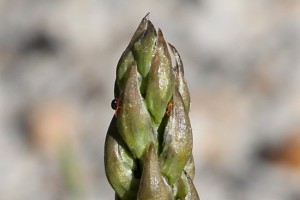Red Legged Earth Mite
 This was supposed to be a post about my asparagus which has just thrown up its first 2 spears, but when I zoomed in on the picture, I saw my first red legged earth mite. I have always read about this in relation to developing clovers in pasture for horses, but I had never actually seen one, which is not surprising as they are only 1mm long. Like many of the pest species in WA, they come from South Africa. The first sighting was in Bunbury in 1917 and are now spread across much of southern Australia.
This was supposed to be a post about my asparagus which has just thrown up its first 2 spears, but when I zoomed in on the picture, I saw my first red legged earth mite. I have always read about this in relation to developing clovers in pasture for horses, but I had never actually seen one, which is not surprising as they are only 1mm long. Like many of the pest species in WA, they come from South Africa. The first sighting was in Bunbury in 1917 and are now spread across much of southern Australia.
The Red legged Earth Mite is mainly a pest of broadleaf species and its reproductive capacity is increased when capeweed is present – which is one of our main weeds. It causes more damage than any other pasture pest which is probably why its Latin name is Halotydeus destructor! According to the CSIRO the yields of susceptible crops can be reduced by half.
It can completely destroy newly sown pastures and also feeds on ryegrass and young cereal crops, especially oats (yippee something else to look out for when we sow the oats next month). It also causes damage to a wide range of vegetables and broadleaf crops such as canola, peas and lupins. It feeds on the upper surface of plants using its adapted mouthparts to lacerate the leaf and suck up the sap. Plants may become stunted and take on a silvery appearance. They also foul the pasture so sheep prefer to graze pasture that is Mite free. We don’t have so much capeweed on the north paddock where the sheep will be going, so hopefully that won’t be an issue for us.
http://www.dpi.vic.gov.au/agriculture/pests-diseases-and-weeds/pest-insects/redlegged-earth-mite

Facebook